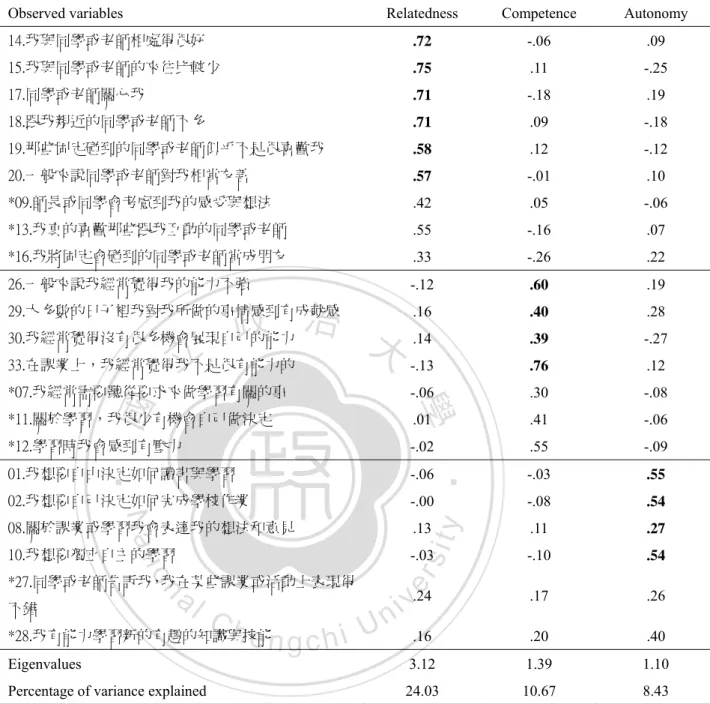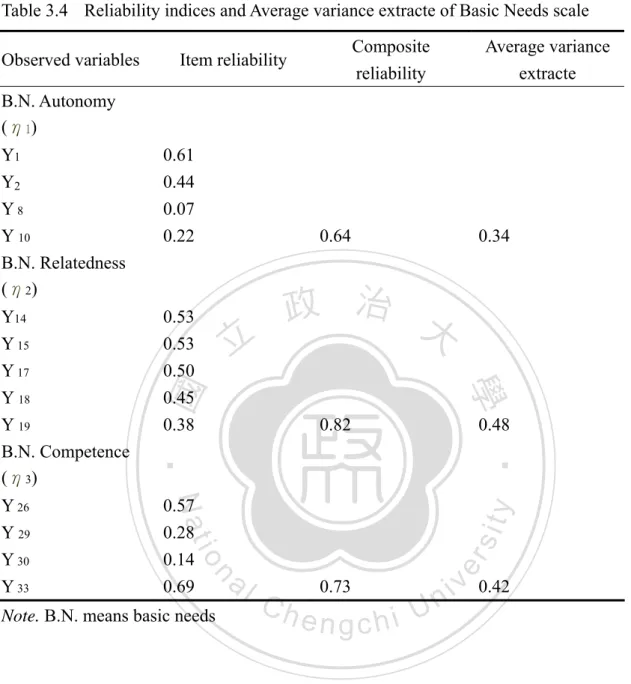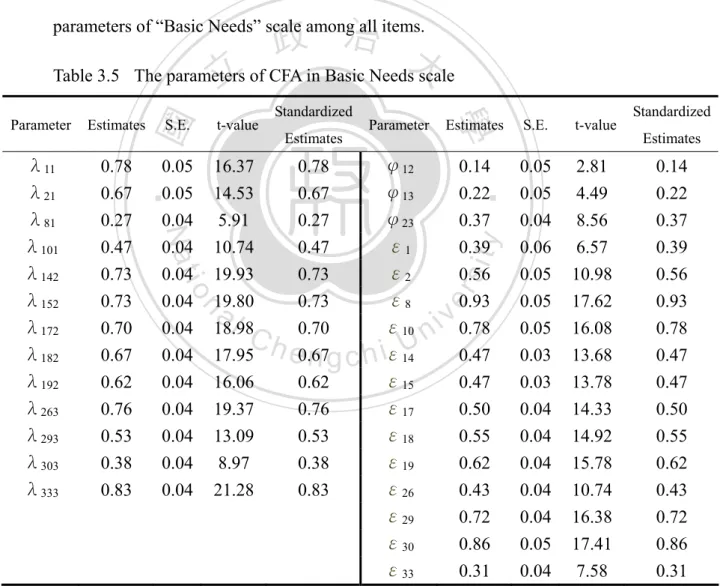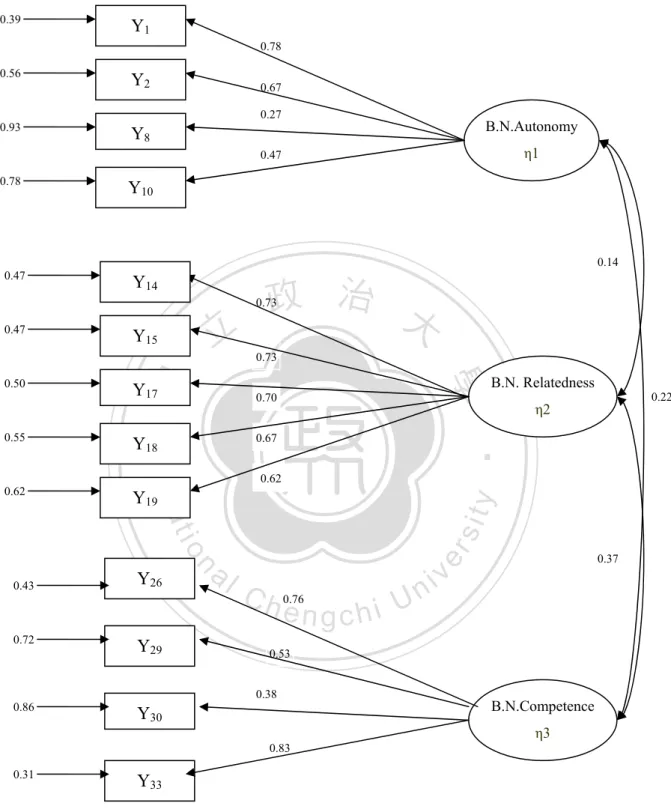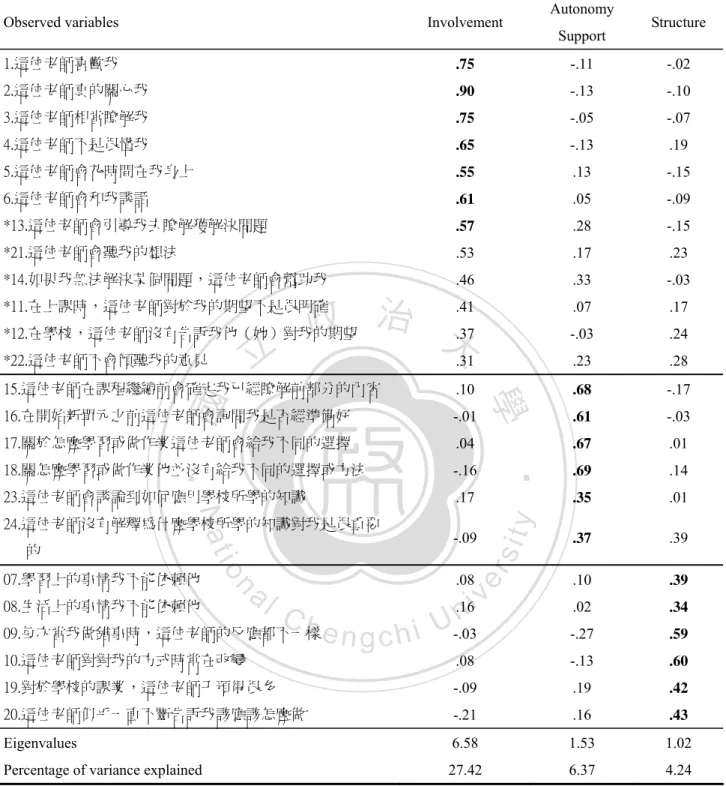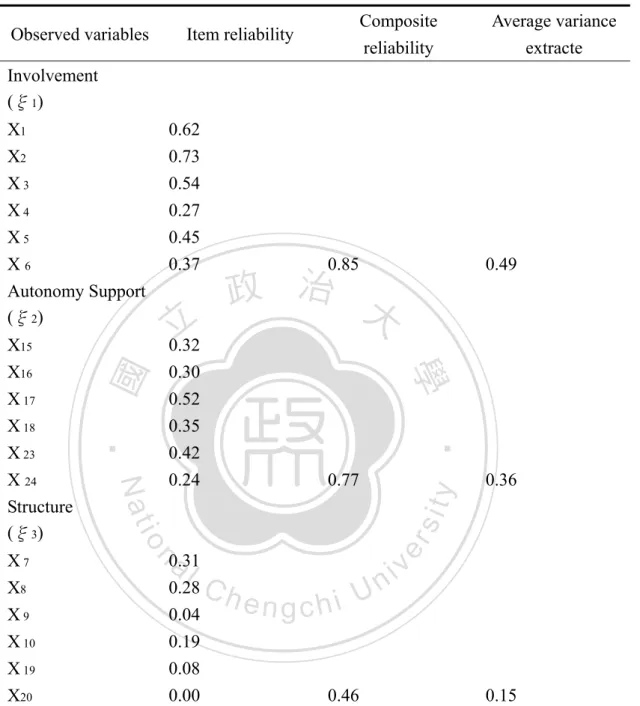教師支持對學生需求滿足與學習投入之影響 - 以台灣地區高中學生為例 - 政大學術集成
122
0
0
全文
(2) 國立政治大學教育學系博士論文. 指導教授 吳靜吉教授 詹志禹教授. ‧. ‧ 國. 學. 政 治 大 立 教師支持對學生需求滿足 與學習投入之影響 - 以台灣地區高中學生為例. n. er. io. sit. y. Nat. al. Ch. engchi. i Un. 研究生:林哲立 中華民國九十九年七月. v.
(3) 謝 誌 良師的提攜與益友的相伴讓我度過充實的博士班學習歷程。 感謝吳靜吉教授與詹志禹教授兩位教授的指導與提攜,兩位教授是我的貴 人亦為榜樣。吳靜吉教授從我一進博士班到最後寫論文過程,這一路以來不斷 的關心與鼓勵,正向積極的看待我的研究,也舒緩了我在最後階段的緊張。 感謝詹志禹教授從探索研究主題以來,不厭其煩的與我討論,嚴謹的治學 態度與學者風範,協助我釐清問題與思考邏輯,還需要包容我急切與固執的個 性。開放積極的態度,. 政 治 大 並提供深入精闢的建議,彌補研究的不足,使我獲益與學習良多。同時要感謝 立. 感謝口試委員施淑慎老師、林偉文老師、梁雲霞老師,在口試階段的鼓勵,. ‧ 國. 學. 在政大的修課期間,王鐘和教授、葉玉珠教授、倪鳴香教授、邱美秀教授的教 導、關心與啟發。. ‧. 感謝博班共同奮鬥的同學們:志業、金香、碧藍,在修課期間以及寫論文. sit. y. Nat. 期間的加油打氣,很高興、很幸運的與你們共同學習與成長。與志業、碧藍的. n. al. 提供各種寶貴意見,還要接受我突然的拜訪。. Ch. engchi. er. io. 小聚會,這樣相互交流與支持的感覺很好。感謝金香的鼓勵,協助施測,並且. i Un. v. 論文寫作過程中,感謝給予大力協助的朋友們。仁豪學長在統計上的即時 解惑;志哲可以說是在統計問題上的幕後功臣,沒有你的幫助,統計分析很難 如期完成;慧瑜在隱喻研究上的大力幫忙,辛苦的協調行政資源;玉桂學姐、 嘉家、榮哲、凱方、青霞、素菁,在施測上的全力協助與鼓勵;傅傑瑞在英文 編修上的慷慨協助;闕助教的行政支援。感謝你們。 爸爸、媽媽從小辛苦的養育,一直到求學階段栽培與鼓勵,也才能夠有今 天的我。謝謝!. 大姊與二姐的關心體貼,以及岳父母的鼓勵與生活上的照. 顧,都是我能夠專心研究的重要支持後盾。 感謝我的內人幸蓉。上課、寫論文這段期間,從不給我壓力,並且給予更.
(4) 多的時間與空間去完成課業,而且承擔所有的事情、也給我最多的建議與支持。 寶貝小女兒柔均,則是寫論文的這一年以來的生活寄託,帶給我們更多的歡樂, 看到她所有的辛苦也都化為喜悅。 感謝自己能夠持續不斷的累積,在求學期間有一整年除了教書之外,持續 在閱讀文獻、寫摘要,這段期間是寂寞的、辛苦的,但這樣的過程是值得的, 儘管這本論文不是完美,但它是可以說服自己、也對得起自己,而這些經驗與 收穫可以幫助自己面對未來的挑戰,繼續向前行。同時,也要回報眾多貴人的 相助,盡己所能幫助更多人。 感謝上天、感謝大家。. 立. 政 治 大. 哲立 2010.07.19. ‧. ‧ 國. 學. n. er. io. sit. y. Nat. al. Ch. engchi. i Un. v.
(5) The effect of Teacher Support on Basic Needs and Learning Engagement in Taiwanese high school context Abstract Based on self-determination theory, the relationships among teacher support, basic needs, and learning engagement were examined. With a total of nine hundred and forty five valid participants from eight Taiwanese high schools, structure equation modeling was used to explore the propose model. The main results of the present study are as follows:. 政 治 大. Teacher autonomy support was the most predictive variable in explaining both. 立. behavioral and emotional engagement, which indicated the cross-cultural application. ‧ 國. 學. of autonomy-supportive teaching in high school context in a collectivistic country. Moreover, teacher involvement could significantly affect basic need of relatedness. ‧. and learning engagement, which showed that teachers’ caring and understanding. y. Nat. sit. should not be ignored in high school context. Also, this study found the differences. n. al. er. io. between need satisfaction and needs among learners, which leaded to distinct results. i Un. v. in reacting to teaching behaviors. Additionally, different from previous studies, this. Ch. engchi. study found that basic need of competence predicted negatively to learning engagement. The specific features of classroom goal structure or teaching methods in Taiwanese high school classrooms might be the plausible explanations.. Keywords:. self-determination theory, basic needs, behavioral engagement,. emotional engagement,. autonomy support. i.
(6) 教師支持對學生需求滿足與學習投入之影響 以台灣地區高中學生為例 本研究之目的在探討在自我決定理論架構下,教師支持(teacher support)、 心理需求(basic needs),以及學習投入(learning engagement)三變項間的關係。本 研究針對台灣地區共八所高中之高中學生為研究對象,進行問卷調查有效樣本 為 945 人。針對研究工具進行探索性因素分析與驗證性因素分析,並以結構方 程模式檢驗本研究之假設模式,研究結果如下。 教師支持與基本需求的關係方面,教師的自主支持(teacher autonomy support)可以顯著的預測能力需求的滿足與學習投入,此結果呈現了自主支持的. 政 治 大. 教學在台灣地區高中情境的跨文化應用。其次,教師投入(teacher involvement). 立. 可顯著的預測關連性的需求滿足與學習投入,此結果說明了教師的關心與支持. ‧ 國. 學. 對高中學生的重要性。 再者,不同過去的研究結果,能力需求的滿足則負向的. ‧. 預測行為投入與情緒投入;此結果呈現了課堂情境因素的重要性,可能影響學. y. Nat. 生之上課投入情形的因素,包括教師的教學方法、教室目標結構,以及學生知. er. io. sit. 覺課堂活動的挑戰性與重要性等。. 最後,本研究也發現,教師支持中的結構(structure)對於自主需求(need of. al. n. iv n C autonomy)有負向的影響,即學生對於自主的需求較高者,對於教師的結構性教 hengchi U. 學會有負向的回應,這也說明了學習者在需求滿足(我覺得)與需求(我想要) 兩者上的差異。 本研究建議未來的研究進一步探討需求滿足與需求對於學習與教師知覺上 的差異情形,並且針對教師結構之問卷進行本土化的概念建構,亦可進一步探 討教師支持與需求滿足間的調節效果或針對這些變項進行長期的調查或課室觀 察。. 關鍵字 自我決定理論. 基本需求. 行為投入. ii. 情緒投入. 自主支持.
(7) Table of Contents Abstract ....................................................................................................... i List of Tables............................................................................................. vi List of Figures .........................................................................................viii Chapter One Introduction ........................................................................ 1 1.1 Research Motivation .......................................................................................... 1 1.2 Research questions ............................................................................................. 3. 政 治 大. 1.3 Definitions of Terms........................................................................................... 4. 立. Chapter Two Literature Review .............................................................. 6. ‧ 國. 學. 2.1 Self-determination theory................................................................................... 6. ‧. 2.1.1 Self-determined motivation...........................................................................7. sit. y. Nat. 2.1.2 Learning Engagement ...................................................................................9. n. al. er. io. 2.1.3 Basic Needs.................................................................................................11. Ch. i Un. v. 2.2 Teacher support ................................................................................................ 15. engchi. 2.2.1 Teacher Autonomy support.........................................................................17 2.2.2 Teacher Structure ........................................................................................22 2.2.3 Teacher Involvement...................................................................................24 2.3 Summary of literature review .......................................................................... 26. Chapter Three. Methodology ................................................................ 27. 3.1 Research Design............................................................................................... 27 3.2 Participants....................................................................................................... 28. iii.
(8) 3.3 Instrument......................................................................................................... 29 3.3.1 Basic Needs ................................................................................................ 30 3.3.2 Teacher Support. ........................................................................................ 39 3.3.3 Learning Engagement ................................................................................ 49. Chapter Four. Results ............................................................................ 56. 4.1 The fitness indicators of the proposed model................................................... 56 4.2 Path analysis among teacher support, basic needs, and learning engagement . 64. 政 治 大. 4.2.1 Teacher Support and Basic Needs.............................................................. 68. 立. 4.2.2 Teacher Support and Learning Engagement .............................................. 69. ‧ 國. 學. 4.2.3 Basic needs and learning engagement........................................................ 70. Discussion....................................................................... 76. sit. y. Nat. Chapter Five. ‧. 4.3 Reduced form of the significant model ............................................................ 71. n. al. er. io. 5.1 General findings of the present study............................................................... 76. i Un. v. 5.2 The effect of teacher autonomy support........................................................... 77. Ch. engchi. 5.2.1 Teacher autonomy support and need of competence ................................. 77 5.2.2 Need of competence and learning engagement.......................................... 78 5.2.3 Teacher autonomy support and need of autonomy .................................... 80 5.2.4 Teacher autonomy support and learning engagement................................ 81 5.3 The effect of teacher involvement.................................................................... 84 5.3.1 Need of relatedness and learning engagement ........................................... 85 5.4 The effect of teacher support of structure......................................................... 87. iv.
(9) 5.4.1 Teacher support of structure and need of autonomy...................................87 5.5 Conclusion ....................................................................................................... 89 5.6 Limitations and suggestions for future research .............................................. 90. References ................................................................................................ 91 Appendix ................................................................................................ 101 Appendix A Basic Need Satisfaction in general (original scale).....................101 Appendix B Basic Needs scale ........................................................................102. 政 治 大. Appendix C Student Report of Teacher Context (original scale) ....................103. 立. Appendix D Teacher Support scale .................................................................105. ‧ 國. 學. Appendix E Engagement vs. Disaffection with Learning ...............................106. ‧. (original scale)....................................................................................................106. sit. y. Nat. Appendix F Learning Engagement scale .........................................................107. n. al. er. io. Appendix G Item correlations of Basic Needs scale .......................................108. i Un. v. Appendix H Item correlations of Teacher Support scale.................................109. Ch. engchi. Appendix I Item correlations of Learning Engagement scale .........................110. v.
(10) List of Tables Table 3.1 Distribution of gender, grade, and surveyed schools of samples ............. 28 Table 3.2 Factor loadings of Basic Needs scale........................................................ 33 Table 3.3 CFA indices of Basic Needs scale ............................................................ 35 Table 3.4 Reliability indices and Average variance extracte of Basic Needs scale.. 36 Table 3.5 The parameters of CFA in Basic Needs scale........................................... 37 Table 3.6 Factor loadings of Teacher Support scale................................................. 42. 政 治 大. Table 3.7 CFA indices of Teacher Support scale...................................................... 43. 立. Table 3.8 Reliability indexes and Average variance extracte of Teacher Support. ‧ 國. 學. scale......................................................................................................... 45. ‧. Table 3.9 The parameters of CFA in Teacher Support scale .................................... 47. Nat. io. sit. y. Table 3.10 Factor loadings of Learning Engagement scale ...................................... 50. n. al. Table3.12. Reliability indices. er. Table 3.11 CFA indices of Learning Engagement scale........................................... 52. iv n C andh Average variance e n g c h i U extracte. of Learning. Engagement scale.................................................................................... 53 Table 3.13 The parameters of CFA in Learning Engagement scale ......................... 54 Table 4.1 Zero-order correlation of the variables..................................................... 57 Table 4.2 The fit indices of present SEM model ...................................................... 60 Table 4.3 Reliability indices and Average variance extracte of all scales in the model ..................................................................................................................................... 61 Table 4.4 All parameters of the present SEM model................................................ 66. vi.
(11) Table 4.5 The effect of latent variables in SEM model ..........................................73 The fit indices of the reduced significant model compared with the significant model......................................................................................75. 立. 政 治 大. 學 ‧. ‧ 國 io. sit. y. Nat. n. al. er. Table 4.6. Ch. engchi. vii. i Un. v.
(12) List of Figures Figure 2.1 The self-system model of motivational development ............................. 16 Figure.2.2. Four teacher characteristics within the provision of a high-quality teacher-student relationship promoting motivation and engagement. .... 25. Figure 3.1 The hypothesized model of the relationship among teacher support, basic needs and engagement............................................................................. 27 Figure 3.2 CFA diagram of Basic Needs scale ......................................................... 38. 政 治 大. Figure 3.3 CFA diagram of Teacher Support scale .................................................. 48. 立. Figure 3.4 CFA diagram of Learning Engagement scale.......................................... 55. ‧ 國. 學. Figure 4.1 The parameter indicators of the hypothesized SEM model .................... 65. ‧. Figure 4.2 Significant paths of the hypothesized model. ......................................... 72. Nat. sit. y. Figure 4.3 Reduced form of the significant relationship between teacher support and. n. al. er. io. learning engagement ............................................................................... 75. Ch. engchi. viii. i Un. v.
(13) Chapter One. Introduction. This introductory chapter includes three parts. Research motivation is presented in the first section. Research questions are listed in the second. Definitions of terms will be listed in the last.. 1.1 Research Motivation Students in Confucian heritage culture or East Asian culture tend to keep a distance from instructors, to be accustomed to teacher-directed instruction and to avoid active involvement. Chinese learners usually regard teachers as competent. 治 政 大 the investigation of learning and authority figure. Under this cultural background, 立. engagement among students could provide practical recommendations for teachers. ‧ 國. 學. and educators in Taiwan. Therefore, cultivating effective schools and promoting. ‧. autonomy of students has become an ultimate goal for school administrators,. sit. y. Nat. educators, teachers, and educational psychologists to pursue. Motivation is a critical. io. er. factor affecting learning behaviors and engagement. The mechanism of how. al. n. motivation is shaped under social context is connected to engagement and well-being. However,. iv n C empirical h e studies i U that n g c hshowed. motivation decreases as. students move to higher grade from elementary, high school, to college years (Lepper, Corpus, & Iyengar, 2005 ; Otis & Pelletier, 2005). This phenomenon raises critical issues regarding how motivation changes and is shaped under social context and individual perceptions. Self-determination motivation focuses on nurturing and protecting individual needs by providing abundant autonomy-support, relatedness, and competence. By nurturing inner sources under proper choice (autonomy), feedback (competence), respect and caring (relatedness), learners produce distinct patterns of engagement. 1.
(14) and motivation. Self-determination theorists assert motivation is shaped under a social context which provides proper autonomy support, structure, and involvement for learners. Psychological needs of students also produce different results of motivation and engagement (Ryan & Deci 2000 a ; Deci, Koestner, & Ryan, 2001). As a result, how teacher support, basic needs, and learning engagement are related should be explored further.. 立. 政 治 大. ‧. ‧ 國. 學. n. er. io. sit. y. Nat. al. Ch. engchi. 2. i Un. v.
(15) 1.2 Research questions Based on self-determination theory, the present research intends to probe deeper the relationship between teacher support, individual needs, self-determined motivation, and engagement. These relationships are still not well investigated ; therefore, the research questions of the present research are as follows: 1. Are student needs of autonomy, competence, and relatedness influenced by teacher support? 2. Is learning engagement affected by need satisfaction?. 政 治 大. 3. Can teacher support affect learning engagement directly ?. 立. ‧. ‧ 國. 學. n. er. io. sit. y. Nat. al. Ch. engchi. 3. i Un. v.
(16) 1.3 Definitions of Terms 1. Teacher autonomy support Teacher autonomy support indicates that students perceive teachers providing choice, showing respect, and fostering relevance in conducting instruction (Reeve, Bolt, and Cai , 1999 ; Assor, Kaplan, & Roth, 2002 ; Skinner, Marchand, Furrer, & Kindermann, 2008). 2. Teacher structure. 政 治 大 Structure of classroom environment indicates that students perceive teachers 立. ‧ 國. 學. providing clear rules, consistent expectations, timely help, and monitoring students learning (Skinner & Belmont, 1993 ; Skinner, et al., 2008).. ‧. 3. Teacher involvement. y. Nat. sit. Teacher involvement indicates that students perceive teachers creating positive. n. al. er. io. relationships with students by providing caring, understanding, and abundant time to. i Un. be together (Skinner & Belmont, 1993 ; Skinner, et al., 2008). 4. Learning engagement. Ch. engchi. v. Learning engagement indicates that students invest effort, persistence, and energy both behaviorally and emotionally. In this study, engagement means students report their behavioral and emotional engagement in the classroom (Skinner & Belmont, 1993) 5. Basic needs Based on self-determination theory, psychological basic needs include competence, relatedness, and autonomy. Student competence belief is a perception of 4.
(17) ability on performing in a specific subject. Relatedness means the relationship with others in the classroom. Autonomy is that learners wish for independence, decision-making, and internal control. In the present study, basic psychological needs are determined by students reporting their perception about basic needs in the classroom (Ryan & Deci, 2000a). .. 立. 政 治 大. ‧. ‧ 國. 學. n. er. io. sit. y. Nat. al. Ch. engchi. 5. i Un. v.
(18) Chapter Two. Literature Review. According to the research questions, self-determination theory will be outlined in the first part of this chapter. Three basic psychological needs in self-determination theory will be discussed in the second part. The third part presents the relationship among teacher support, needs satisfaction, and learning engagement.. 政 治 大. 2.1 Self-determination theory. 立. Self-determination indicates an internal control of volition to specific goals,. ‧ 國. 學. tasks, subjects, or behaviors. Personal ability, inner resources, potentials, and interests should be nurtured, cultivated and developed in order to promote. ‧. well-being (Deci & Ryan 2008). Effective school should provide context to fulfill. Nat. sit. y. and nurture students’ inner resources, motivation, and interests Additionally,. n. al. er. io. self-regulated and self-management are goals in self-determination to help learners. i Un. v. manage, construct, and integrate knowledge and life events. Self-determination. Ch. engchi. context focuses on learner-centered instruction, constructive learning methods, exploration as learning goal, and provides students with abundant opportunities to explore and scaffold their learning experience. Learners with different prior knowledge receive proper cognitive scaffolding to guide their learning. Learners actively manage, regulate, and participate in their learning through inquiring, exploring, and collaborating, which is beneficial for citizens to manage the real challenges and problems in the future, such as ill-structure problems, lure of advertisements, ill-reasoned political persuasions. Not only does exploration orientation promote epistemological belief but also provide the authentic context 6.
(19) that modern citizens will face in modern society (Deci & Ryan, 1985 ; Deci, Vallerand, Pelletier, & Ryan, 1991 ; Ryan & Deci, 2000a ; Ryan & Deci, 2000b ; Flum & Kaplan, 2006 ; Hmelo-Silver, Duncan, & Chinn, 2007). People in countries with high social connection, more social rules and strict regulation have less self-determination in pursuing personal interest and goals compared with people in Western countries. It was found that people in egalitarian countries have more autonomy and also tend have more personal oriented goals compared with other collective heritage countries such as China or South Korea. 政 治 大 expectation and pressure becomes an external constrain that undermine intrinsic 立 (Downie, Koestner, ElGeledi, & Cree 2004 ; Dekker, 2008). Perceived high social. ‧ 國. 學. motivation. Self-determination in Chinese culture has been doubted since students tend to hold less autonomous motivation compared with western students. Learners. ‧. in collectivistic countries hold external learning motivation in order to gain social. sit. y. Nat. status, approval, and identity from significant others. Also studying to please or. io. er. honor their family is a popular phenomenon and motivation for student in East Asian. al. iv n C h einton g information and personal needs their h i U as well as how these social c self-system, n. countries. Therefore, how students in highly-connected societies internalize social. and individual needs influence learning outcomes become issues which need to be explored further (Jang, Reeve, Ryan, & Kim, 2009).. 2.1.1 Self-determined motivation Organismic integration theory is a sub-theory of self-determination theory. Internalization indicates that a person integrates externally-controlled events into a consistent personal value. External events are evaluated into personal values. Information includes supporting and controlling aspects affecting internal control.. 7.
(20) If a person perceives a task as uncontrollable, it causes low self-determined motivation and undermines intrinsic motivation. The spectrum of motivational types shows a person’s internal reaction toward learning tasks. From intrinsic motivation to amotivation, this spectrum represents different internal desires to conduct the specific task from highly internal willingness to the least willingness (Ryan & Deci, 2000a ; Ryan & Deci, 2000b). People may face various tasks where they are not always intrinsically motivated at school or work. This organismic integration process displays that people will evaluate and integrate personal and social information as goals to guide how much behavioral, emotional and cognitive. 政 治 大. effort they should make. The spectrum of motivations from intrinsic motivation to. 立. extrinsic is listed as follows (Deci, Vallerand, Pelletier, & Ryan, 1991):. ‧ 國. 學. 1. External regulation refers to behaviors are conducted because of external. ‧. information such as rewards or punishment. This represents the least. sit. y. Nat. self-determined form of extrinsic motivation.. n. al. er. io. 2. Introjected regulation specifies that tasks are seen as protecting one’s. i Un. v. self-esteem and self-worth in order to avoid feeling guilty or anxiety.. Ch. engchi. 3. Identified regulation means conducting the task due to personal importance or conscious valuing of the activity. This activity is performed because of its usefulness or instrumentality of the specific goal. Identified motivation can also be beneficial in learning compared with intrinsic motivation (Walls & Little, 2005). 4. Integration regulation is a process whereby an individual’s needs, interests, and identities are integrated into a coherent whole which is personally important or valued. 5. Intrinsic motivation means performing a specific task due to its internal. 8.
(21) interests and desires. Most empirical studies show consistent results of this spectrum of motivations. Autonomous motivation is related to positive learning outcomes and controlled motivation related to maladaptive learning outcomes (Fortier, Vallerand, & Guay, 1995 ; Otis & Pelletier, 2005 ; Ratelle, Guay, Vallerand, Larose, & Senecal, 2007 ; Shih, 2008 ; Vansteenkiste, Zhou, Lens, & Soenens, 2005). As predicted, amotivation is connected with negative learning outcomes (Vallerand, Fortier, & Guay, 1997 ; Legault, Green-Demers, & Pelletier, 2006). Additionally, students with. 政 治 大 motivation or amotivation (Lepper et al., 2005 ; Walker, Greene, & Mansell, 2006 ; 立. intrinsic motivation produce more cognitive engagement than those with extrinsic. ‧ 國. 學. Legault et al, 2006). Motivation toward a specific task is changeable because it can be framed or transformed according to different types of social environment such. ‧. as autonomy supportive teachers or positive relationship among classmates.. sit. y. Nat. Instructors in classroom context affect students at every moment by providing. n. al. er. io. various tasks and information. This information can affect how a person judges and. i Un. v. integrates learning beliefs into internal volition or motivation. Teaching behaviors. Ch. engchi. from more autonomy-supportive to controlling classroom influence student perception, motivation, emotion, and learning strategies. (Ryan & Deci, 2000a; Ryan & Deci, 2000b).. 2.1.2 Learning Engagement Learning engagement indicates that students invest effort, persistence, and energy behaviorally, cognitively, and emotionally in the classroom (Fredricks, Blumenfeld, & Paris, 2004). Promoting engagement has become an educational goal for educators and serves as another indication of learning outcome compared with. 9.
(22) achievement. Even though high engagement does not always lead to high learning achievement (Fredericks et al., 2004), engagement is accessible to well-being and satisfaction with life. Learning tasks that foster flow experience (an intensive engagement) by providing an optimal balance of challenges and skills, self-realization values, intensive effort, and individual importance can lead to positive feelings, well-being and satisfaction with life (Waterman, 2005). Engagement has also been connected to positive outcomes from autonomous motivation, confidence, higher relatedness, mastery orientation, and optimism (Skinner & Belmont, 1993 ; Skinner, et al., 2008 ; Skinner, Kindermann, & Furrer,. 政 治 大. 2009). Classroom climates and student variables are influential to academic. 立. engagement. In elementary classrooms, teacher support of involvement, structure,. ‧ 國. 學. and autonomy could predict emotional and behavioral engagement (Skinner &. ‧. Belmont, 1993 ; Assor, Kaplan, Kanat-Maymon, and Roth, 2005 ; Skinner, et al.,. y. Nat. 2008 ; Skinner, et al., 2009). Consistent findings were found in middle school and. er. io. sit. college settings where support of autonomy, involvement, and structure could predict student engagement (Vansteenkiste et al., 2005 ; Zimmer-Gembeck, Chipuer,. al. n. iv n C Hanisch, Creed, & McGregor, 2006 ; h Jang, et al., 2009). e n g c h i UFor example, Jang et al. found perceived autonomy support and psychological needs could predict. engagement among Korean high school students. However, this research failed to explore other classroom features such as structure and involvement which have been proved to be critical in nurturing engagement. In personal variables, the relationship between individual needs (needs for autonomy, relatedness, and competence) and engagement have been suggested to be explored further because few studies have studies these issues. Moreover, research samples should expand from elementary school students to other levels of students. 10.
(23) in predicting engagement (Fredricks, et al., 2004).. 2.1.3 Basic Needs Based on self-determination theory, fulfilling human basic psychological needs (autonomy, competence, and relatedness) affects students’ well-being, life satisfaction, and motivation (Sheldon, Ryan, & Reis, 1996 ; Reis, Sheldon, Gable, Roscoe, & Ryan, 2000 ; Deci, Ryan, Gagne, Leone, Usunov, and Kornazheva, 2001; Sheldon & Krieger, 2007). Studies have showed that basic needs play a critical role in predicting general well-being. For example, Reis et al probed three basic needs. 政 治 大. according to college students’ daily activities and found the three needs served a. 立. significant role in emotional well-being. In an another research, Sheldon and. ‧ 國. 學. Krieger applied longitudinal method and found that perceived autonomy could predict students’ needs, which then in turn affected academic motivation, well-being,. ‧. and academic grades.. y. Nat. er. io. sit. Basic need of competence is a perception of ability towards performing a specific subject or task. Competence is related to the concept of self-efficacy, which. al. n. iv n C indicates a personal belief in h performing the task. e n g c h i U Providing performance related feedback, persuasion, and modeling can affect one’s efficacy belief. However, just. having high competence belief is not sufficient for a learner to accomplish a task. Personal domain knowledge and supportive context shape the sense of competence belief (Deci et al., 2001). Basic need of relatedness means the connections or relationship with family members, friends, relatives, and teachers. In daily events, meaningful talk, feelings of being understood, and appreciated by others can affect their sense of relatedness (Reis et al., 2000). In classroom contexts, students perceive relatedness in the. 11.
(24) classroom as having a pivotal effect on motivation, engagement, emotion, achievement and well-being (Roeser, Midgley, & Urdan, 1996 ; Furrer & Skinner, 2003 ; Davis, 2006 ; Juvonen, 2007 ; Bao & Lam, 2008 ; Martin & Dowson, 2009). Basic need of autonomy in learning indicates that learners are provided with choice, chances of exploration, and sharing opinions in order to develop their inner resources and values (Reeve & Jang, 2006). The satisfaction of psychological needs affects how learners perceive and respond to the information in the classroom. Students with more adaptive profiles of. 政 治 大 with less satisfaction tend to 立 react more maladaptively. Cultivating a classroom psychological needs tend to react positively toward social context while students. ‧ 國. 學. context that nurtures needs of autonomy, relatedness, and competence can promote engagement and motivation. For example, Haenze and Berger (2007) applied jigsaw. ‧. cooperative learning instruction and found that the experience of three basic needs. sit. y. Nat. mediated the effect of instruction. Moreover, increasing the feeling of competence. n. al. er. io. with the cooperative learning classroom was associated with better performance in. i Un. v. physics. In another research, Krapp (2005) applied ESM (Example Sampling. Ch. engchi. Method) and retrospect interview to probe vocational students’ intrinsic motivation and interest experience. Results showed that perceived autonomy support and competence were significant variables shaping vocational students’ intrinsic motivation and interest experience. School context, that meets basic needs of students, can facilitate well-being and motivation among students (Levesque, Zuehlke, Stanek, & Ryan, 2004 ; Krapp, 2005 ; Zimmer-Gembeck, et al., 2006). For example, Zimmer-Gembeck et al. found that both classroom context and school environment promoted the needs of autonomy, competence, and relatedness predicting students’ engagement and 12.
(25) achievement. Satisfying students’ autonomy, competence, and relatedness can be guidelines in classroom teaching. For example, Filak and Sheldon (2003) found that the fulfillment of three basic needs affected college students’ course evaluation. Therefore, classroom teaching behaviors can be either facilitating and detrimental depending on cultivating optimal competence, autonomy, and relatedness. When teachers meet three basic needs of students, learners can produce adaptive engagement, such as Katz and Assor (2007) argued that autonomy choice will be. 政 治 大 autonomy, competence, and relatedness. Choice should meet student interest and 立. effective in facilitating engagement when the options meet the students’ need for. ‧ 國. 學. values (autonomy), providing proper challenge (competence), and facilitating peer support rather than comparison (relatedness).. ‧. The application of basic needs between collectivistic cultures and. sit. y. Nat. individualistic cultures has been debated. Self-determination theory proposes the. n. al. er. io. universality as well as cross-cultural application of the three needs. Also some. i Un. v. studies have proved this point (Deci et al., 2001). Deci et al found that autonomy. Ch. engchi. support can affect the perception of need satisfaction, and need satisfaction in turn affected well-being and working engagement between two working contexts: United States and Bulgaria. They found that Bulgarian workers perceived autonomy support less from top managements compared with American workers. Jang et al (2009) investigated Korean high school students and found that collectivism and parental influences failed to moderate the relationship between teachers support and learning outcomes, which showed that three basic needs satisfaction were universal and cross- cultural. In recent years, several studies have investigated Taiwanese junior high school 13.
(26) students and showed that the three basic needs could directly affect autonomous motivation (Chien, 2009), learning interest (Hsueh, 2009), and learning goals (Hsieh, 2008), those of which then influence outcome variables such as self-regulated learning behaviors, achievement, and academic emotions. For example, Chien (2009) adapted “Basic Need satisfaction” scale and investigated Taiwanese junior high students, finding that sense of autonomy can predict autonomous motivation. Students’ sense of competence was the most predictive variable. Also, mastery goal adoption of parents and teachers can predict three senses of basic need satisfaction. Another research, Hsieh (2008) investigated Taiwanese junior high school students. 政 治 大. and found that three basic needs could predict different types of goals in learning.. 立. Moreover, need of autonomy could positively predict learning goals, discipline goals,. ‧ 國. 學. and reward goals as well as negatively predicted reward goals and complying goals.. ‧. Need of relatedness could positively predict social goals. Therefore, the three basic. y. sit. io. n. al. er. Taiwan.. Nat. needs should play some role in students’ learning in a collectivistic country in. Ch. engchi. 14. i Un. v.
(27) 2.2 Teacher support Engagement and motivation have become critical issues to explore. Teachers profoundly affect students learning and models of teacher support for motivation and engagement have been proposed. Skinner et al. (2008) proposed a model called self-system processes, which integrates four dimensions: context, self-system process, action, and outcomes. The context dimension is where teachers provide optimal structure, warmth, and autonomy support compared with teacher rejection, chaos and rejection. Second, the self-system components comprise competence. 政 治 大. belief, relatedness, and autonomy which mediates the relation between context and. 立. action. Third, context and self-system create different actions and outcomes. Based. ‧ 國. 學. on the self-system model as depicts in Figure 2.1, teacher support of autonomy structure, autonomy, and involvement affect personal agency (sense of autonomy,. ‧. competence, and relatedness), which influences personal actions such as motivation,. Nat. io. sit. y. engagement, and learning outcomes.. n. al. er. Teacher support of structure, autonomy support, and involvement have been. Ch. i Un. v. proven to be predictors of engagement and autonomous motivation (Skinner &. engchi. Belmont, 1993 ; Marchland & Skinner, 2007 ; Skinner, et al., 2008 ; Zimmer-Gembeck, et al., 2006). For example, Skinner and Belmont (1993) found that teacher structure, which provides clear rules, consistent expectations, timely help, and monitoring student learning, predicts student behavior engagement. Teacher involvement shaped by creating a warm and affectionate climate promotes emotional engagement. Moreover, if students have lower behavioral engagement, teachers tend to conduct more suppressive and controlling teaching behaviors. The teacher-student relationship is dynamic and interactive process. In addition, Skinner et al. (2009) applied the research methodology of survey and field observation, and 15.
(28) found that teacher support of structure, autonomy, and involvement was positively correlated with behavioral and emotional engagement. Context. Action. Self. TEACHER. Autonomy. Engagement. Warmth, Structure, and. 立. Disaffection. and. 政 治 大 Engaged. Engaged. Behavior. Behavior. Relatedness. 學. Internal Dynamics Engaged. Engaged. Behavior. Behavior. ‧. Coercion. ‧ 國. versus. and. Learning. Competence. support. Chaos,. vs. Achievement. Autonomy. Rejection,. Outcome. n. er. io. sit. y. Nat. al. Ch. engchi. i Un. v. Figure 2.1 The self-system model of motivational development Source: “Engagement and disaffection in the classroom: Part of a larger motivational dynamic? ” E. A. Skinner, et al., 2008, Journal of Educational Psychology, 100(4), 765-781.. 16.
(29) 2.2.1 Teacher Autonomy support Autonomy support has been proven to be one of the effective teaching attitude and technique in promoting students’ engagement and motivation (Chirkov & Ryan, 2001). Research has identified autonomy supportive and controlling teaching behaviors such as the study by Reeve and Jang (2006). They investigated teaching behaviors by conducting “ Problems in Schools ” questionnaire to assess how teachers conduct instruction in the classroom. They conclude autonomy support teaching behaviors are as follows: (1) provide time-spent listening, (2) time spent holding instructional materials, (3)frequency of directives, (4) frequency of questions. 政 治 大. about what the student wants, (5) frequency of contingent responses to the students’. 立. questions, (6) number of perspective-taking empathetic statements, (7) extent of. ‧ 國. 學. support for intrinsic motivation, and (8) extent of support for internalization (provides. ‧. rationale, promotes value of education ). On the contrary, controlling teaching behaviors include suppressing criticism, intruding, forcing un-meaningful acts, which. y. Nat. io. sit. are correlated with negative feelings. Taken together, autonomy support teaching. n. al. er. behaviors comprise some critical components: providing choices, showing respect,. Ch. i Un. v. fostering relevance (Reeve et al., 1999 ; Assor, et al., 2002 ; Skinner & Belmont, 1993).. engchi. Providing choice One important autonomy support behaviors is providing choice. Teachers might provide various choices such as topics to study, reading materials, methods of assessment, activities, social arrangements, and procedural choices. Choice can enhance the sense of control and volition during learning tasks and lead to positive feelings (Schraw, Flowerday, & Reisetter, 1998 ; Flowerday & Schraw, 2000). However, choice may not be effective in facilitating cognitive engagement (Assor, et. 17.
(30) al., 2002 ; Stefanou, Perencevich, DiCintio, & Turner, 2004). Choice is motivating when connecting with their psychological needs (autonomy, relatedness, and competence), and interests (Katz & Assor, 2007). Offering trivial or ill-connected choices may lead to ineffective outcomes such as too much time spending on discussion or increasing too much cognitive load. Giving choices that are relevant to their academic goals and learning methods can efficiently keep learners in their learning tack (Blumenfeld et al., 1991 ; Stefanou, et al., 2004).. Foster Relevance. 政 治 大 between learning materials and立 student interests. Students might usually ask “why I. Foster relevance means teachers provide meaningfulness, values, relations. ‧ 國. 學. need to study this subject?” Valuing learning tasks is important in shaping positive attitude toward learning. Empirical research, Assor et al., (2002) clarified autonomy. ‧. enhancing and suppressing behaviors from 3rd to 8th graders and yielded three. sit. y. Nat. autonomy enhancing behaviors : foster relevance, allowing criticism, and providing. n. al. er. io. choice. Foster relevance can predict behavioral engagement, cognitive engagement,. i Un. v. and positive feelings. However, providing choice can only predict positive feelings.. Ch. engchi. Therefore, providing rational for learning is of great importance to create their positive feelings and engagement. Foster relevance can be made by continuous dialogue with students, sharing the meaningful of the learning material, and also providing authentic experience to help them value their learning (Flum & Kaplan, 2006 ; Brophy, 2008). Brophy applied the concept of ZPD (Zone of Proximal Development) to motivation when teachers use various instructional methods to scaffold student motivation and help students value their learning. According to different levels of motivation among students, teachers apply different levels of instruction to scaffold their motivation. 18.
(31) Showing respect Showing respect means that the classroom climate is safe to share opinions, collaborate, and work together in a healthy classroom process. The central ideas of self-determination are to provide context with security, respect, and caring that can help students explore and feel free to make mistakes (Flum & Kaplan, 2006). In addition, listening to students’ ideas, and opinions can be advantageous in both creating positive teacher-student relationship and deep learning outcomes. Ryan and Patrick (2001) found that mutual respect in the elementary math classroom can. 政 治 大 leaner-centered instruction and self-determination theory, teachers should listen to 立 predict adaptive behaviors and self-regulated learning. Based on the benefits of. ‧ 國. 學. students’ ideas, opinions, and explanations in order to shape a safe learning climate (Ryan & Patrick, 2001; Cornelius-White, 2007).. ‧. Teacher role in autonomy support context. y. Nat. sit. Teachers play a critical role in shaping students’ learning experience. However,. n. al. er. io. teachers may conduct different autonomy-supportive or controlling behaviors. One. i Un. v. reason is that teachers receive pressure from the school administrations and parents. Ch. engchi. (Pelletier, Seguin-Levesque, & Legault, 2002 ; Cai, Reeve, & Robinson, 2002). In addition, teacher individual characteristics such as resilience and adaptive motivation also affect their teaching behaviors and student learning outcomes (Skinner & Belmont, 1993 ; Roth, Assor, Maymon-Kanat, 2007 ; Klusmann, Kunter, Trautwein, Luedtke, & Baumert, 2008). Since autonomy support has become an effective philosophy of education, training teachers to be autonomy-supportive has been shown to be helpful for teachers and students. Non-controlled autonomy support instruction for teachers is teachable and can also produce beneficial outcomes (Reeve, Jang, Carrell, Jeon, & Barch, 2004). 19.
(32) Perceived autonomy support and learning outcomes Student perceived autonomy support predicts autonomous motivation from elementary students to college students (Garcia & Pintrich, 1996 ; Handre & Reeve, 2003 ; Roth, et al., 2007 ; Shih, 2008). Moreover, perceived autonomy support can predict adaptive learning outcomes such as interest experience (Tsai, Kunter, Luedtke, Trautwein, & Ryan, 2008), school performance (Hardre & Reeve, 2003), and positive and behavior engagement (Assor, et al., 2002 ; Zimmer-Gembeck et al., 2006). Much research has been done regarding the autonomy support teaching. Hardre probed. 政 治 大 be more autonomous, perceived higher competence, and produced more positive 立. high school students who perceived more autonomy support from teachers tended to. ‧ 國. 學. outcomes such as school performance and intention to persist learning. Roth et al. investigated Israeli elementary school students and showed that teachers’ autonomous. ‧. motivation for teaching was positively correlated with their autonomy supportive. sit. y. Nat. teaching and student autonomous motivation. Tsai et al. investigated college learners. io. er. in Germany finding that autonomy supportive climate and cognitive support can. al. iv n C h e nandgautonomy They found that cognitive autonomy support c h i Usupportive climate but not n. predict interest experience in three subjects: math, German, and foreign language.. controlling behaviors could predict student interest experience Based on self-determination theory and empirical studies, the prediction can be made that teacher autonomy support can both fulfill the needs of autonomy and promote engagement as well as self-regulated motivation.. 20.
(33) Autonomy support classroom in Taiwan Chinese students are more passive and are afraid to make errors. Whether self-determination can apply into Chinese culture needs further study. One study found cultural differences among Asian American students and Caucasian American students. Lepper et al. (2005) found intrinsic motivation and extrinsic motivation decreased significantly across third to eighth graders. Cultural differences exist between Asian and Caucasian American students. Asian American students tend to have more extrinsic motivation than Caucasian American students. Overall, the. 政 治 大 found that Taiwanese立 junior high school students and their perceived autonomy effect of autonomy support can also be adopted in Chinese culture. Shih (2008). ‧ 國. 學. support could predict intrinsic motivation, identified motivation, and introjected regulation, but not external regulation. She also found that perceived autonomy. ‧. predicted behavioral engagement. In addition, d’Ailly (2003) studied Taiwanese. sit. y. Nat. elementary school students and found that their perceived teacher autonomy support. al. n. achievement.. er. io. could predict self-determined motivation, which in turn had no effect on. Ch. engchi. 21. i Un. v.
(34) 2.2.2 Teacher Structure Structure of the classroom environment indicates that teachers provide clear rules, consistent expectations, timely-help, and monitoring students learning (Skinner & Belmont, 1993 ; Skinner, et al., 2008). Fostering autonomy support in the classroom is effective and necessary but not sufficient because too much autonomy may lead to an ineffective and chaotic classroom situation. The optimal combination of autonomy support and structure in the classroom becomes more prominent in creating high engagement and motivation (Ames, 1992 ; Fredricks, et. 政 治 大. al., 2004 ; Davis, 2006 ; Reeve, 2006 ; Sierens, Vansteenkiste, Goossens, Soenens, &. 立. Dochy, 2009). .. ‧ 國. 學. A classroom which provides too much autonomy without proper guidance might lead to ineffective results. Teachers might often apply cooperative learning as a. ‧. method to enhance involvement and sense of autonomy. When students engage in a. y. Nat. io. sit. peer discussion course, it does not lead to real support for less competent learners. n. al. er. (Puntambekar & Hubscher, 2005). Constructive learning, cooperative learning. Ch. i Un. v. instruction, and collaborative argument are the methods usually used by teachers. In. engchi. an inquiry learning classroom, learners have to search, connect, and analyze related information. Low achievers without having proper prior knowledge may not be able to draw connections among concepts and cause the increasing of cognitive load (Green & Gredler, 2002 ; Schmidt, Loyens, van Gog, & Paas, 2007). For example, Hijzen, Boekaerts, & Vedder (2007) probed effective and ineffective cooperative learning instruction. The effective cooperative learning group yielded more mastery goals than ineffective groups.. In this study, ineffective. cooperative groups were characteristic of having too much autonomy, less guidance,. 22.
(35) and improper tasks (too easy or challenging). Therefore, teacher monitoring student learning and providing timely- help became critical. Additionally, Sierens et al. (2009) proved that high school students perceiving teacher structure had main effect on self-regulated learning and cognitive strategy use. However, perceived autonomy support teaching served no main effect. Structure and autonomy support had an interactive effect on self-regulated learning. Only under high autonomy-supportive classroom conditions could structure of classroom environment had its best function in the classroom. As a result, it can be concluded that proper classroom structure with clear rules, consistent expectations, timely-help, and monitoring can be vital to student learning.. 立. 政 治 大. ‧. ‧ 國. 學. n. er. io. sit. y. Nat. al. Ch. engchi. 23. i Un. v.
(36) 2.2.3 Teacher Involvement Involvement indicates that teachers create positive relationships with students by providing caring, understanding, and abundant time to be together, which fulfills a sense of relatedness of learners. School belonging, relatedness, and interpersonal relationships are critical in cultivating student motivation, cognition, and emotion (Anderman, 2002 ; Juvonen, 2007 ; Martin & Dowson, 2009). Relatedness can be implemented at the level of school, classroom, and student. At school, effective leadership that builds the sense of school as a community enhances belonging and. 政 治 大. connectedness. At the classroom level, teachers not only promote positive. 立. meaningfully connect learners’ live (Martin & Dowson, 2009).. 學. ‧ 國. relationships in class such as autonomy support, respect, and caring, but also. ‧. At the classroom level, the teacher-student relationship has been proved to be. y. Nat. critical in facilitating self-regulation strategies, engagement, and achievement. er. io. sit. (Patrick and Ryan, 2007 ; Skinner, et al., 2008). Both emotional and academic supports are critical factors for teachers to provide. For example, Patrick and Ryan. al. n. iv n C (2007) showed that teacher support (emotionally academically) and peer support h e n g and chi U would promote self-regulation strategies and achievement. This study suggested that. teacher emotional support was critical in shaping personal mastery goal adoption and academic efficacy. Teacher involvement indicates nurturing positive teacher-student relationships. Reeve (2006) proposed creating a high quality relationship with four classroom characteristics: attunement, relatedness, supportiveness, and gentle discipline. Attunement means that teachers adjust their teaching according to students’ authentic understanding. Relatedness, supportiveness, and gentle discipline promote. 24.
(37) a balanced learning environment which is not over-structured or under-structured. Figure 2.2 presents four factors that create positive relationship, motivation, and engagement.. Attunement. Students’ positive motivation and Engagement. Relatedness High-quality Relationship with teachers. Supportiveness. 學. ‧ 國. 立. 政 治 大. Gentle Discipline. ‧. Figure.2.2 Four teacher characteristics within the provision of a high-quality. io. sit. y. Nat. teacher-student relationship promoting motivation and engagement.. n. al. er. Source: “Teachers as facilitators: What autonomy-supportive teachers do and why their students benefit,” J. Reeve, 2006, Elementary School Journal, 106(3), 225-236.. Ch. engchi. 25. i Un. v.
(38) 2.3 Summary of literature review To have effective teaching, teachers should understand unconscious motivation and needs held by students in order to help pupils become active learners. Creating a proper self-determination classroom by creating optimal autonomy support, structure, and involvement can meet students’ basic needs. High school teachers and students in Taiwan undertake the pressure of passing college entrance exams. The issue of how teacher support affects student basic needs and adaptive outcomes is still in its infancy. Based on the literature review, teacher. 政 治 大. support (involvement, structure, autonomy) plays a critical role in satisfying. 立. psychological needs, which influence learning engagement. Few studies have been. ‧ 國. 學. conducted to probe the interrelation between classroom teacher support, basic needs and learning outcomes. Only Jang et al. (2009) investigated Korean high school. ‧. students’ perceived autonomy support, psychological needs, and engagement. They. y. Nat. io. sit. found that basic needs were critical in predicting engagement and motivation.. n. al. er. However, this study failed to explore teachers’ structure and involvement, which have. Ch. i Un. v. also been proven to be important in shaping positive results. In this research, student. engchi. need for relatedness did not predict outcome variables. A possible explanation is that high school students in Asian societies tend to see teachers as professional figures rather than wanting to closer or expecting support. Therefore, teachers support and individual needs require further exploration. The present study proposes a research model whereby basic psychological needs should be nurtured in teacher support consisting autonomy, involvement, and structure, which can facilitate adaptive outcomes. The proposed causal model has not been fully tested in previous research. The findings of this study should enhance our understanding of teacher support, basic needs, and learning engagement. 26.
(39) Chapter Three. Methodology. This chapter presented the research methods and procedures of the study including research design and participants. This chapter also included the result of exploratory factor analysis and confirmatory factor analysis in three instruments.. 3.1 Research Design The purpose of this study was to explore teacher support, basic needs, and engagement among Taiwanese senior high students. In order to answer research questions adequately, structural equation modeling (SEM) was used to reach the. 治 政 大 purpose of the study by exploring the path relationship among variables. The 立 學. ‧ 國. hypothesized model of relationship among teacher support, basic needs, and engagement is shown in Figure 3.1.. ‧. Teacher support. Basic need. Nat. Engagement. io. Teacher. al. Autonomy. n. autonomy support. Teacher. Ch. er. sit. y. Learning. n engchi U. iv. Competence. structure. Teacher. Behavioral engagement. Emotional engagement. Relatedness. involvement. Figure 3.1 The hypothesized model of the relationship among teacher support, basic needs and engagement. 27.
(40) 3.2 Participants Participants in the present study were public and private high school students. A total of one thousand one hundred and thirty-two questionnaires were distributed, which were surveyed from eight high schools, and all participants were normal high school students excluding vocational high school students. High school students in Taiwan prepare for enrollment in colleges, and they are different from students in vocational high schools. Five hundred and forty-five were valid questionnaires. There were two hundred and twelve grade-one students, three hundred and seven. 政 治 大. grade-two students, and four hundred and twenty-six grade-three students. The. 立. descriptive statistics of valid cases are shown in Table 3.1.. ‧ 國. 學. Table 3.1 Distribution of gender, grade, and surveyed schools of samples. En-Ken (安康) Shen-Wu (醒吾) Ching-Shui (清水) Chung-Chang (中正) Central South Subtotal Total. Ho-Zon (后綜) Gu-Shen (鼓山). 17. 8. 16. --. 12. 21. --. al. --. C--h. e n --g c h i. Male. Female. Subtotal. 19. 83. 41. 92. 166. 17. 57. 74. 7. y. 16. n. (竹東). Female. sit. Ju-Don. Male. er. (育成). Female. Grade 3. io. Yu-Chen. Male. Nat. North. Schools. Grade 2. ‧. Areas. Grade 1. ni --U. v. --. --. 29. 50. 11. 27. 117. 29. 29. 22. 8. 26. 28. 142. --. --. 33. 31. 9. 18. 91. 25. 41. 20. 40. 25. 37. 188. 19. 36. 2. 14. 2. 11. 84. 89. 123. 126. 180. 138. 289. 212. 307. 28. 426. 945.
(41) 3.3 Instrument In order to test the research model, instruments were conducted to investigate research variables in the proposed model. Three instruments were administrated: “Teacher Support”, “Basic Needs”, and “Learning Engagement.” These instruments were translated into Chinese and all items were answered using five-point Likert scales, which ranged from 1 (completely disagree) to 5 (completely agree).The translations from Chinese English were checked by a native American who is a assistant professor in a technical university in northern Taiwan.. 政 治 大 learners in Taiwan. A group of high school students got together to respond to each 立 Moreover, to better understand the application of scales among high school. ‧ 國. 學. item of the three scales in the present study. Researcher asked focused group members about how they felt when responding to these scales.. ‧. Both exploratory factor analysis (EFA) and confirmatory factor analysis (CFA). sit. y. Nat. were applied to test the validity and reliability of the scales because the instruments. n. al. er. io. in the present study had never been applied in a Taiwanese context.. i Un. v. By randomly selecting participants from 945 cases, 287 cases were used to. Ch. engchi. implement exploratory factor analysis and the other 658 cases were used to conduct confirmatory factor analyses. Before implementing factor analysis, KMO indicators and Bartlett’s test were examined to test the property of performing exploratory factor analysis. Then, principal axis factoring was used as extraction method and Promax oblimin rotation method was adopted. Second, confirmatory factor Analysis (CFA) was conducted by using LISREL 8.70 to examine the validity of the measure so as to determine whether the observed variables fit the latent variables well.. 29.
(42) 3.3.1 Basic Needs The original “Basic Need Satisfaction” assesses need satisfaction in one’s general life (Deci & Ryan, 2000). In the original scale, autonomy (7 items) assesses students’ beliefs of how they are able to choose and control what they do (e.g., I feel like I am free to decide for myself how to live my life”). Competence (6 items) measures the degree to which one feels efficacious about the task (e.g., “I often do not feel very capable”). Relatedness (8 items) probes the degree to which one feels a sense of belonging and connection with others. (e.g., “I really like the people I. 政 治 大. interact with “). Appendix A contains the full list of the original instrument.. 立. ‧ 國. 學. 3.3.1.1 Exploratory Factor Analysis of Basic Needs scale. ‧. In the present study, the “Basic Need Satisfaction” was adapted so as to fit into context. named. “Basic. Needs“. scale.. y. learning. sit. school. Nat. high. Based. on. n. al. er. io. three-dimensional conceptualizations of the original scale, three factors of “Basic. i Un. v. Needs” scale were predetermined as the numbers of factors. By comparing factor. Ch. engchi. loadings of each item, some items were ruled out. Table 3.2 shows the result of exploratory factor analysis. Appendix B shows the “Basic Needs“ scale, that was used in the present study. “Basic Need of Relatedness” was the first subscale, which measured students’ relationships with classmates and teachers. The eigenvalue of the preliminary factor analysis was 3.12, and this factor could explain 24.03 % of the variance. Then, some items were ruled out by comparing the factor loadings of the items. Item 13 and item 16 were deleted because of lower factor loading compared with other items in this factor. In addition, item 9 “Teachers and classmates tend to take my feelings into 30.
(43) consideration.” (師長或同學會考慮到我的感受與想法) was merged in this factor, but it belonged to subscale “Basic Need of Autonomy”, so it was deleted. Therefore, “Basic Need of Relatedness” included five items as follows: item 15 (I don’t have a lot of contacts with teachers and classmates.) (我與同學或老師的來往比較少) (factor loading = .75), item 14 (I get along well with classmates and teachers.)(我與 同學或老師相處得很好) (factor loading = .72), item 18 (There are not many classmates or teachers that I am close to)(跟我親近的同學或老師不多) (factor loading = .71), item 17 (Classmates and teachers care about me.) (同學或老師關心 我) (factor loading = .71), item 19 (My classmates and teachers I interact with. 政 治 大. regularly do not seem to like me much.)(那些固定碰到的同學或老師似乎不是很. 立. 喜歡我) (factor loading = .58), and item 20 (Classmates and teachers are generally. ‧ 國. 學. pretty friendly towards me.) (一般來說同學或老師對我相當友善) (factor loading. ‧. = .57). In the end, this factor contained five items.. sit. y. Nat. “Basic Need of Competence” was the second subscale, which measured the. io. er. students’ subjective perception about their ability in a high school learning context.. al. iv n C this factor could explain 10.67h% eofn the h i U Then, some items were ruled out g cvariance. n. The preliminary factor analysis showed that eigenvalue of this factor was 1.39, and. by comparing the factor loadings of the items. Item 11, item 12, and item 7 did not belong to this factor, so they were deleted. This factor included four items : item 33” I do not feel very capable on my studying ” (在課業上我經常覺得我不是很有能力 的 ) (factor loading = .76), item 26 “Generally speaking, I am not very competent.”(一般來說我經常覺得我的能力不強) (factor loading = .60), item 29” “ Most days I feel a sense of accomplishment from what I do”(大多數的日子裡我 對我所做的事情感到有成就感) (factor loading = .40), and item 30 ”I do not get much of a chance to show how capable I am.“ (我經常覺得沒有很多機會展現自. 31.
(44) 己的能力)( factor loading = .39). This factor contained four items in the end. “Basic Need of Autonomy” was the third factor, which measured students’ need for autonomy, self-control, and decision for their learning. The preliminary factor analysis showed that eigenvalue of this factor was 1.10, and this factor could explain 8.43 % of the variance. Item 27 and item 28 were merged in this factor, but they originally belonged to “Basic Need of Relatedness.” Therefore, they were deleted. “Basic Need of Autonomy” comprised four items: item 1 “I want to decide for myself how to study.” (我想要自由決定如何讀書與學習) ( factor loading = .55),. 政 治 大 = .54), item 2 “I want to decide for myself how to do my homework. “ (我想要自己 立. item 10 “I want to learn independently.” (我想要獨立自主的學習) ( factor loading. ‧ 國. 學. 決定如何完成學校作業) (factor loading = .54), and item 8 “I will express my opinion and ideas.“(關於課業或學習上我會表達我的想法與意見) (factor loading. ‧. = .27). This factor contained four items.. n. er. io. sit. y. Nat. al. Ch. engchi. 32. i Un. v.
(45) Table 3.2 Factor loadings of Basic Needs scale Observed variables. Relatedness. Competence. Autonomy. 14.我與同學或老師相處得很好. .72. -.06. .09. 15.我與同學或老師的來往比較少. .75. .11. -.25. 17.同學或老師關心我. .71. -.18. .19. 18.跟我親近的同學或老師不多. .71. .09. -.18. 19.那些固定碰到的同學或老師似乎不是很喜歡我. .58. .12. -.12. 20.一般來說同學或老師對我相當友善. .57. -.01. .10. *09.師長或同學會考慮到我的感受與想法. .42. .05. -.06. *13.我真的喜歡那些跟我互動的同學或老師. .55. -.16. .07. *16.我將固定會碰到的同學或老師當成朋友. .33. -.26. .22. 26.一般來說我經常覺得我的能力不強. -.12. .60. .19. 政 治 大 30.我經常覺得沒有很多機會展現自己的能力 33.在課業上,我經常覺得我不是很有能力的 立. .16. .40. .28. .14. .39. -.27. -.13. .76. .12. -.06. .30. -.08. 29.大多數的日子裡我對我所做的事情感到有成就感. .01. .41. -.06. *12.學習時我會感到有壓力. -.02. .55. -.09. 01.我想要自由決定如何讀書與學習. -.06. .55. 02.我想要自己決定如何完成學校作業. -.00. -.08. .54. -.03. 08.關於課業或學習我會表達我的想法和意見. .13. y. .11. .27. 10.我想要獨立自主的學習. -.03. -.10. .54. v.24 i n. .17. .26. .16. .20. .40. 3.12. 1.39. 1.10. 24.03. 10.67. 8.43. *27.同學或老師告訴我,我在某些課業或活動上表現得. al. n. 不錯. Ch. engchi U. *28.我有能力學習新的有趣的知識與技能 Eigenvalues Percentage of variance explained. Note. * indicates items were deleted. 33. er. io. sit. Nat. ‧. ‧ 國. *11.關於學習,我很少有機會自己做決定. 學. *07.我經常需要聽從要求來做學習有關的事.
(46) 3.3.1.2 Confirmatory Factor Analysis of “Basic Needs” scale Confirmatory Factor Analysis was performed to test whether three latent variables of this scale fitted with the observed items. Quality of whole scale and internal quality of the scale were examined. First, quality of whole model can be screened by three set of the fit indexes including absolute fit indices, relative fit indices, and parsimonious fit indices. Second, internal quality of the scale could be examined by item reliability, composite reliability, and average variance extracte. Third, lambda (λ) and error variance (ε) displayed the quality of the scale.. 政 治 大 absolute fit indices, relative fit 立 indices, and parsimonious fit indices were proposed. First, to examine the fitness of the whole scale, three set of the fit indices:. ‧ 國. 學. The result showed that the construction of the latent variables fit the data well (RMSEA= .067 ; GFI= .94 ; AGFI = .92, NFI = .93, NNFI = .93, PNFI = .74, PGFI. ‧. = .64 , See Table 3.3). The first set of absolute fit indices showed how covariance. sit. y. Nat. matrix matched among theoretical model and observed data, which included three. n. al. er. io. indices AGFI (adjusted goodness of fit index), GFI (goodness of fit Index), and. i Un. v. RMSEA (the root mean square error of approximation). The value of AGFI and GFI. Ch. engchi. above 0.9 represents the good fit of the model. AGFI (.92) and GFI (.94) of “ Basic Needs “ scale were all above .90, showing a good fit of the scale. Another absolute fit index is RMSEA. The criterion of RMSEA is that the value below .06 is considered good model fit, between .06 and .08 is reasonable fit, as well as between .08 and 0.10 is mediocre fit. RMSEA of this scale was .067, indicating a reasonable fit of the scale. The second set of indices is relative fit indices, which include NFI (normed fit index) and NNFI (non-normed fit index). They compare the increase of fitness between theoretical model and independence model. The higher value it is the more fitness it suggests. The value of NFI and NNFI above .90 represent good fit of the model. 34.
(47) NFI and NNFI of the scale were all above .90, showing good quality of the scale. The third set of index is parsimonious fit indices, which measure how the model can be estimated by the least parameters under the criterion of the model fit. The values of PNFI (parsimony normed fit index) and PGFI (parsimony goodness of fit index) higher than .50 represent an acceptable result. PNFI (.74) and PGFI (.64) of “ Basic Needs ” scale were all above .50.. Table 3.3 CFA indices of Basic Needs scale Absolute fit dices X2. df. RMSEA. GFI. 243.24. 62. .067. .95 立. Relative fit indices. NFI NNFI 政 治 大 .93 .92 .93. AGFI. Parsimonious indices. CFI. IFI. PNFI. PGFI. .95. .95. .74. .64. ‧ 國. 學. Second, internal quality of each item in the scale can be examined by item. ‧. reliability, composite reliability, and average variance extracte (See Table 3.4). First,. y. Nat. individual item reliability means the variance that can be explained by each item.. er. io. sit. Usually, the value of individual item reliability above .45 represents a good result. Most items were above .45, but some items were under this value. The second index. al. n. iv n C is composite reliability, which the reliability between several observed h emeasures ngchi U items and one. latent valuable. Often, the criterion of composite reliability is .70,. indicting good composit reliability of each factor. The values of composite reliability in this scale are as follows: “Basic Need of Relatedness” (.64), “Basic Needs of Autonomy”(.82), and “Basic Need of Competence”(.73). The next index similar to composite reliability is average variance extracte, which shows the total variance of one latent variable that can be explained by those observed items. The average variance extracte of “Basic Need of Relatedness” and “Basic Need of Competence” were all above .40, but only the value of “Basic Need of Autonomy ” (.34) was a. 35.
(48) little under the criteria, which was still an acceptable result. Table 3.4 Reliability indices and Average variance extracte of Basic Needs scale Observed variables. Composite reliability. Item reliability. Average variance extracte. B.N. Autonomy (η1) Y1 Y2 Y8 Y 10 B.N. Relatedness (η2). 0.61 0.44 0.07 0.22. Y14 Y 15. 0.53. ‧ 國. 0.82. 0.48. ‧ y. sit. n. al. Note. B.N. means basic needs. Ch. 0.73. engchi. 36. er. 0.57 0.28 0.14 0.69. io. Y 29 Y 30 Y 33. 政 治 大. Nat. Y 26. 立. 0.53 0.50 0.45 0.38. 0.34. 學. Y 17 Y 18 Y 19 B.N. Competence (η3). 0.64. i Un. v. 0.42.
(49) Third, lambda (λ) and error variance (ε) are two indices that can also present the quality of the scale. Lambda represents the factor loading between each observed variable and the latent variables. Often, the value of lambda is between 0.5 and 0.8, and should reach a significant level. Although some items were lower than the criterion, most lambdas were between 0.5 and 0.8 (λ11 to λ27). Another index is error variance. This value should be all positive and reach a significant level. All error variances of this scale (ε11 toε27) were all positive and significant, which reached the basic criterion of the measurement. Table 3.5 and Figure 3.2 depict the. 政 治 大 The parameters 立 of CFA in Basic Needs scale. 0.78 0.67 0.27 0.47 0.73 0.73 0.70 0.67 0.62 0.76 0.53 0.38 0.83. 0.05 0.05 0.04 0.04 0.04 0.04 0.04 0.04 0.04 0.04 0.04 0.04 0.04. 16.37 14.53 5.91 10.74 19.93 19.80 18.98 17.95 16.06 19.37 13.09 8.97 21.28. io. n. λ192 λ263 λ293 λ303 λ333. al. Ch. Estimates. 0.78 0.67 0.27 0.47 0.73 0.73 0.70 0.67 0.62 0.76 0.53 0.38 0.83. Parameter. Estimates. S.E.. t-value. φ12 φ13 φ23 ε1 ε2 ε8 ε10 ε14 ε15 ε17 ε18 ε19 ε26. 0.14 0.22 0.37 0.39 0.56 0.93 0.78 0.47 0.47 0.50 0.55 0.62 0.43 0.72 0.86 0.31. 0.05 0.05 0.04 0.06 0.05 0.05 0.05 0.03 0.03 0.04 0.04 0.04 0.04 0.04 0.05 0.04. 2.81 4.49 8.56 6.57 10.98 17.62 16.08 13.68 13.78 14.33 14.92 15.78 10.74 16.38 17.41 7.58. engchi. i Un. ε29 ε30 ε33. 37. y. λ11 λ21 λ81 λ101 λ142 λ152 λ172 λ182. Standardized. sit. t-value. ‧. S.E.. 學. Estimates. Nat. Parameter. er. Table 3.5. ‧ 國. parameters of “Basic Needs” scale among all items.. v. Standardized Estimates. 0.14 0.22 0.37 0.39 0.56 0.93 0.78 0.47 0.47 0.50 0.55 0.62 0.43 0.72 0.86 0.31.
(50) 0.39. Y1 0.78. 0.56. 0.93. Y2. 0.67 0.27. B.N.Autonomy. Y8. η1. 0.47 0.78. Y10. 0.14 0.47. Y14. 政 治 大. 0.73. 0.67. Y18. 0.62. Nat. 0.86. Y29. sit. al. n. 0.72. Y26. ni C h 0.76 U engchi. 0.37. v. 0.53 0.38. B.N.Competence. Y30. η3 0.83 0.31. 0.22. η2. y. Y19. io. 0.43. B.N. Relatedness. er. 0.62. 0.70. ‧. 0.55. Y17. 0.73. 學. 0.50. 立. Y15. ‧ 國. 0.47. Y33. Figure 3.2 CFA diagram of Basic Needs scale. 38.
數據

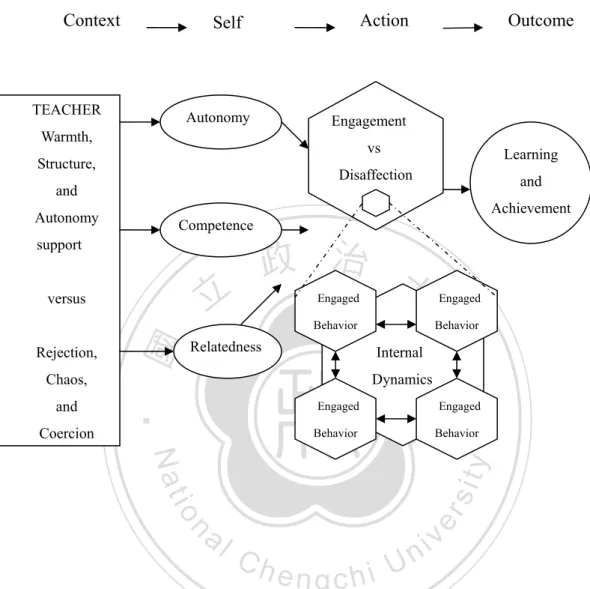
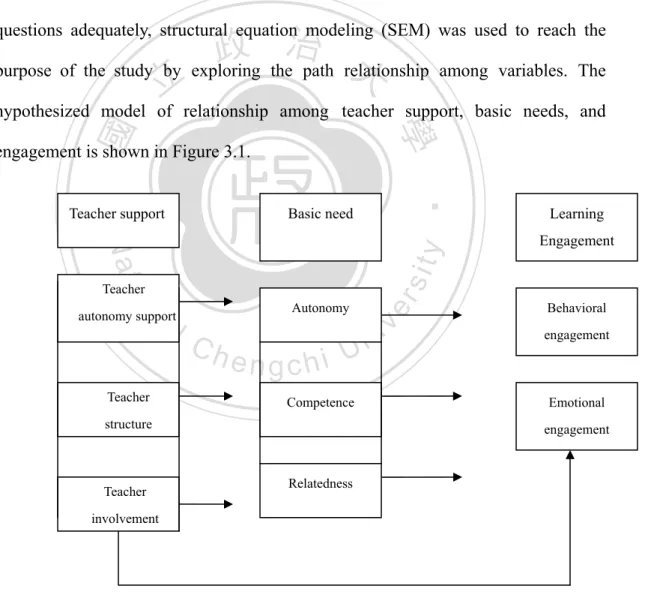
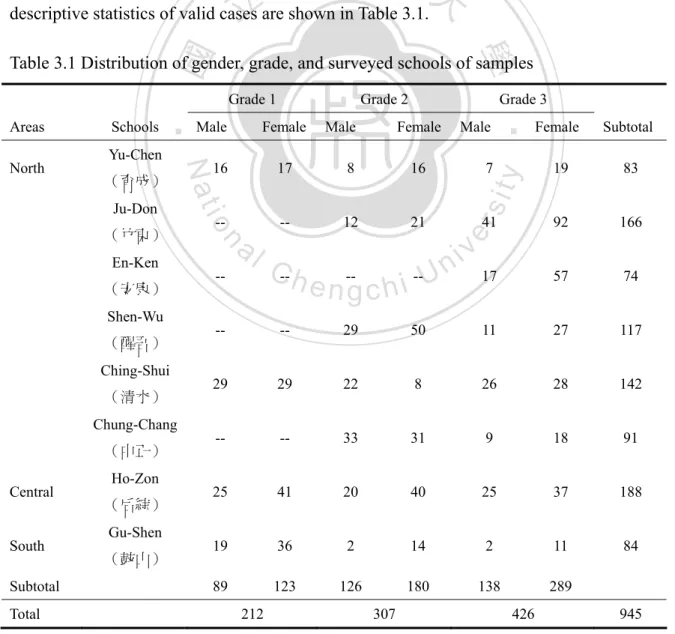
+7
相關文件
生源主要來自屋邨,家庭 社經地位不高,但絕大部 分學生品德純良,喜愛學 習,家長願意與學校携手
3) 日常逐步發展不同的學與教策略,尋求校內 ( 行政 ) 與校外 ( 資源 ) 支援,留意機會,以擴闊學生的學習 經驗. 4)
學校如何善用 資源為教育工 作及學習過程 中製造成功與 快樂..
通過蒐集學生在各方面(包 括學習 過程和結果 )的學習 顯證,然後詮釋資料,判斷 學生的表現,藉以向學生、.
The research mainly focuses on the consulting process of students' leavening behaviors, and that is by way of activities of meditation sitting to reflect upon humanity's sincerity
(authentic)與互動式學習情境 教師為主體,獎勵服從一致性 師生平等對待,學習者為主體 教師為知識傳遞者
(authentic)與互動式學習情境 教師為主體,獎勵服從一致性 師生平等對待,學習者為主體 教師為知識傳遞者
假說 H3-1 不同「服務年資」對「學生學習成效」有顯著差異。 支持 假說 H3-2 不同「教師職稱」對「學生學習成效」有顯著差異。 支持 假說
